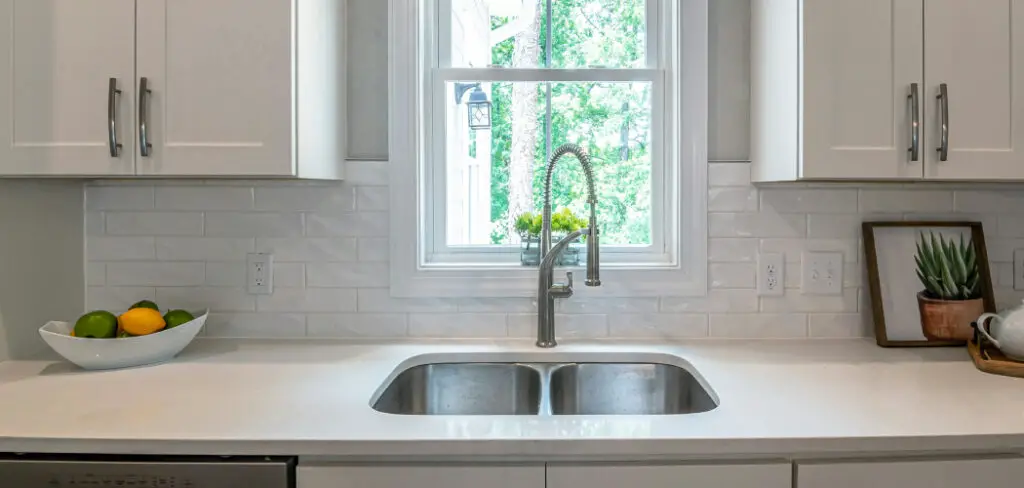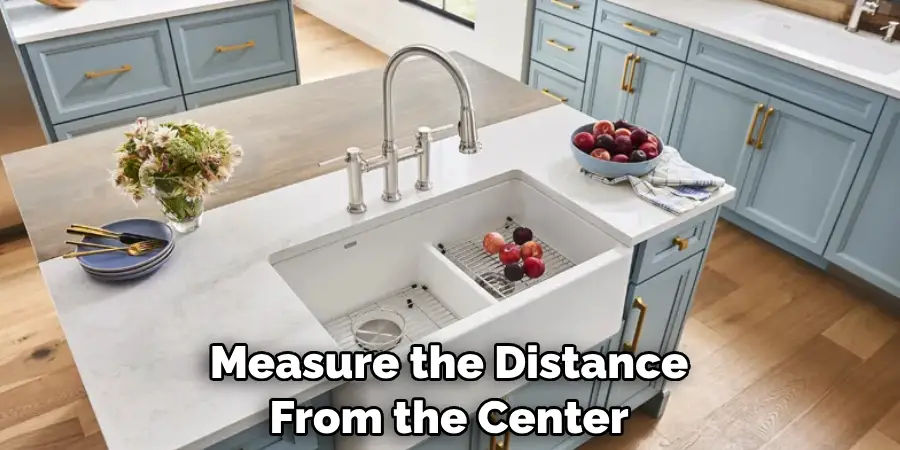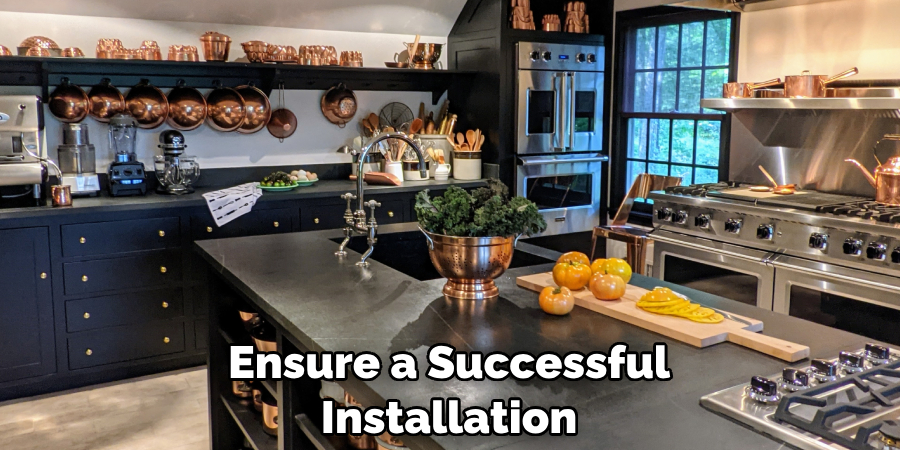Measuring for a new kitchen faucet is a critical first step in the process of upgrading or replacing this essential fixture. Whether aiming for a simple replacement or a complete kitchen makeover, accurate measurements ensure a seamless installation and optimal functionality.
From determining the sink’s mounting holes and faucet center to considering spout reach and height, each dimension plays a vital role in selecting the right faucet for your kitchen.

Understanding how to measure for a new kitchen faucet empowers homeowners and DIY enthusiasts to confidently navigate the vast array of options available, ensuring compatibility with their existing sink and meeting their specific needs and preferences.
In this comprehensive guide, we’ll explore the step-by-step process of how to measure for new kitchen faucet, providing valuable insights and expert tips to help you make an informed decision and achieve a successful installation.
Importance of Proper Measurement
Proper measurement is paramount when selecting a new kitchen faucet, as even the slightest miscalculation can lead to significant issues during installation or affect the faucet’s functionality.
Accurate measurements ensure that the new faucet will fit perfectly with the existing sink configuration, avoiding the need for costly modifications or the inconvenience of returns. Furthermore, proper fitting faucets help prevent leaks and water damage, which can stem from mismatched sizes between the faucet and sink’s mounting holes.
Beyond functionality, accurate measurements also play a crucial role in maintaining the aesthetics of the kitchen, ensuring that the faucet complements the overall design without overpowering or underwhelming the space.
Ultimately, taking the time to measure accurately before purchasing a new faucet saves time, money, and ensures a harmonious blend of form and function in the kitchen environment.
Benefits of Upgrading Kitchen Faucet
Upgrading your kitchen faucet can significantly enhance the functionality, efficiency, and aesthetic appeal of one of the most used spaces in your home. A new faucet can introduce the latest features, such as improved water saving capabilities, which contribute to reducing your environmental footprint and lowering utility bills.
Modern faucets come with innovations like touchless technology, which promotes hygiene and convenience by minimizing the need to touch faucet handles with dirty hands.
Additionally, upgrading to a high-quality faucet can increase the overall value of your home, making it an attractive feature for potential buyers if you plan to sell in the future.
Aesthetic improvements cannot be overlooked either; a new faucet can serve as a focal point in your kitchen, complementing your home décor and reflecting your personal style. Finally, replacing an old, leaky faucet with a new one can prevent water damage and mold growth, promoting a healthier home environment.

Assessing Current Faucet Setup
Before venturing into the market for a new kitchen faucet, it’s essential to thoroughly assess your current faucet setup. This assessment involves more than just measuring; it requires a comprehensive evaluation of your current faucet’s performance, design, and any issues you’re facing with it.
Start by identifying the type of faucet you have and the number of mounting holes your sink or countertop offers. Note any features your current faucet includes, such as a sprayer or soap dispenser, and decide if these are must-haves in your new faucet.
Additionally, consider the water flow rate and whether it meets your needs or if an upgrade could increase efficiency. Reflect on the style and finish of your current faucet – does it complement your kitchen’s aesthetic, or is it time for a visual update?
Finally, troubleshoot any problems like leaks, inconsistent water pressure, or difficulty in handling, as these issues can guide your priorities for the new faucet.
By conducting a detailed assessment of your current faucet setup, you’ll have a clearer understanding of what to look for in a new faucet, ensuring that you choose a model that addresses both functional needs and personal tastes.
Identifying Faucet Type
Identifying the type of faucet installed in your kitchen is a pivotal step in the measurement and selection process for a new kitchen faucet. Kitchen faucets primarily come in four different types, distinguished by their internal mechanisms and installation setups:
compression, ball, disc, and cartridge.
Compression faucets are the eldest type, using rubber washers to control the flow of water and requiring a tighter turn to shut off completely. They often exhibit leaks when the washer wears out.
Ball faucets, recognizable by their single handle controlling both temperature and flow, utilize a ball bearing for operation.
Cartridge faucets can have one or two handles; their movement is smoother because they operate with a replaceable cartridge that controls the flow of water.
Finally, disc faucets are the newest technology, featuring a single lever over a wide cylindrical body, and are known for their reliability and use of a pair of ceramic discs for water flow regulation.
Recognizing your current faucet’s type not only aids in selecting a suitable replacement but also informs you about the complexity and potential costs involved in the installation process. For those considering an upgrade or a style change, understanding these types can help in making an educated decision that matches both functional requirements and aesthetic preferences.

Noting Mounting Holes Configuration
Once you’ve identified the type of faucet currently installed in your kitchen, the next crucial step is to examine the configuration of the mounting holes. Typically, kitchen sinks come with one to four pre-drilled holes to accommodate various types of faucets and accessories like soap dispensers or sprayers.
Understanding the configuration and number of these holes is essential for selecting a new faucet that will fit without requiring new holes to be drilled or existing ones to be modified, which could complicate the installation process and incur additional costs.
- Single-hole faucets are sleek and ideal for smaller sinks, offering a clean look by integrating both the spout and handle(s) into one unit. If your current setup has more than one hole, some faucets come with an optional escutcheon plate to cover the unused holes.
- Two-hole setups offer flexibility for adding an accessory, such as a side sprayer or a soap dispenser, alongside the main faucet.
- Three-hole configurations are common and typically used for faucets with two separate handles for hot and cold water, plus the spout. A soap dispenser or a sprayer can occupy the third hole.
- Four-hole sinks allow for the widest range of faucet and accessory combinations, including the addition of a filtered water tap or a hot water dispenser.
It’s also worth noting the distance between the centers of the outermost holes (if your sink has more than one) as this “spread” can vary and is crucial for ensuring your new faucet fits perfectly. This step not only aids in making a precise selection but also helps to envision how the new faucet will complement your kitchen’s aesthetics and functionality.
By meticulously noting the mounting holes configuration, you ensure a smoother transition to your new kitchen faucet, aligning practicality with design preferences.

Measuring Sink and Faucet Openings
Accurate measurement of your sink and faucet openings is a fundamental step in selecting a new kitchen faucet. This ensures the new faucet not only fits perfectly but also aligns with the aesthetics and functionality of your kitchen space.
Before you start measuring, ensure you have a tape measure, a notepad, and a pen or pencil handy for recording the dimensions.
- Sink Opening: Start by measuring the diameter of the hole or holes where the faucet will be installed. Most standard sink openings are about 1-1/2 inches in diameter, but it’s crucial to measure to confirm. If your sink has a cover plate, measure the length and width of the plate as well, since it might hide additional openings that could be used or need to be covered.
- Faucet Base: Measure the base of your current faucet if it’s still installed, focusing on the diameter to ensure the new faucet base will cover the sink’s opening or the existing escutcheon plate if one is used.
- Distance Between Holes: For sinks with more than one hole, measure the distance from the center of one hole to the center of the next. This is especially important for faucets with separate hot and cold water handles.
- Depth and Clearance: Don’t forget to measure the depth of your sink and the clearance above it. You’ll want to make sure that your new faucet is tall enough to comfortably fit pots and pans under but not so tall that it causes splashing or fits awkwardly within your kitchen’s space.
By meticulously measuring sink and faucet openings, you are taking a critical step toward a successful faucet selection and installation process. These dimensions will guide you in choosing a faucet that not only meets your functional needs but also complements your kitchen’s design, ensuring a seamless blend of utility and style.

Determining Faucet Hole Spacing
To ensure the perfect fit for your new kitchen faucet, determining the exact spacing between the faucet holes on your sink is crucial. This measurement is commonly referred to as the “faucet hole spacing” and is particularly important if you’re opting for a faucet design with multiple components, such as those with separate hot and cold water handles.
- Standard Spacing: Most sink designs adhere to a standard faucet hole spacing of 4 inches, known as the centerset configuration. However, widespread faucet setups, where the handles and spout are separate pieces, may feature a spacing of 6 to 16 inches.
- How to Measure: Use a tape measure to find the distance from the center of the leftmost hole to the center of the rightmost hole. This is straightforward for a three-hole configuration but may require careful calculation for setups with more than three holes, especially if they’re not in a straight line.
- Evaluating Your Sink: If you’re dealing with a one-hole configuration, the spacing is not a concern, as your focus will be on the diameter of this hole. For sinks with more than three holes, assess whether the outermost holes align with the standard centerset or widespread measurements, or if you’ll need to seek out a faucet specifically designed to fit your unique configuration.
Understanding the faucet hole spacing is not only essential for selecting a new faucet but also for ensuring compatibility with your kitchen sink’s existing layout.
This knowledge enables you to make informed decisions, whether you’re seeking minimalistic elegance or a more complex arrangement with additional functionalities like sprayers or soap dispensers, all while maintaining the integrity of your kitchen’s design.

10 Methods How to Measure for New Kitchen Faucet
1. Identify Sink Configuration:
Begin by identifying the configuration of your sink. Determine the number of mounting holes available on the sink deck or countertop. Common configurations include single-hole, three-hole, and four-hole setups. Knowing the number and spacing of the mounting holes will help you choose a compatible faucet. Additionally, consider the style and design of your sink as it may impact the type of faucet you can install.
2. Measure Faucet Hole Spacing:
If your sink has multiple mounting holes, measure the distance between them to determine the faucet hole spacing. Use a tape measure to measure the center-to-center distance between each hole. This measurement is crucial for selecting a faucet that aligns with the existing hole spacing. Common faucet hole spacing options include 4 inches, 6 inches, and 8 inches.
3. Determine Faucet Center:
For sinks with multiple mounting holes, determine the center point between the holes. This center point represents the ideal location for the center of the faucet base. Measure the distance from the center point to each hole to ensure accurate placement of the new faucet.
Faucet center is an important factor to consider when installing a new faucet. It not only determines the stability and balance of the faucet but also affects its overall appearance. A misaligned faucet can throw off the symmetry and aesthetic of your sink, making it look unbalanced and unpleasant.
4. Measure Sink Width:
Measure the width of the sink from one outer edge to the other. This measurement will help you choose a faucet with an appropriate spout reach, ensuring that the water stream reaches the center of the sink basin without splashing onto the countertop or backsplash. Additionally, make sure to account for any obstructions or objects near the sink that may affect the placement of the faucet.
5. Determine Spout Reach:
Spout reach refers to the distance from the center of the faucet base to the center of the water stream. Measure the distance from the center of the mounting hole to the front edge of the sink to determine the maximum spout reach needed for adequate coverage of the sink basin.

6. Consider Spout Height:
Spout height is another important consideration when choosing a new kitchen faucet. Measure the distance from the mounting surface to the highest point of the sink’s rim or backsplash. This measurement will help you select a faucet with an appropriate spout height that allows ample clearance for filling pots and pans.
7. Account for Clearance:
Ensure that there is adequate clearance between the faucet spout and any obstacles such as the backsplash or overhead cabinets. Measure the distance from the mounting surface to the nearest obstruction to determine the maximum height and reach allowed for the new faucet.
8. Check for Compatibility:
Before purchasing a new faucet, check the manufacturer’s specifications to ensure compatibility with your sink configuration and measurements. Look for faucets that are designed to fit the number of mounting holes and spacing on your sink, as well as those with the appropriate spout reach and height.
9. Consider Additional Features:
When selecting a new kitchen faucet, consider additional features that may enhance functionality and convenience. This could include pull-down or pull-out sprayers, touchless or motion-sensing technology, and adjustable water flow and temperature settings. Ensure that the faucet’s design and features align with your needs and preferences.
10. Seek Professional Assistance (if needed):
If you’re unsure about how to measure for a new kitchen faucet or if you encounter any challenges during the process, don’t hesitate to seek professional assistance.
Consult with a plumber or kitchen designer who can offer expert guidance and recommendations based on your specific sink configuration and requirements. A professional can help ensure a successful installation and optimal performance of your new faucet.

Conclusion
In conclusion, accurately measuring for a new kitchen faucet is crucial for ensuring a seamless installation process and optimal functionality in your kitchen. By following the step-by-step guide provided in this comprehensive resource, you can confidently determine the right size and style of faucet to fit your sink configuration and meet your needs.
Remember to assess your current setup, measure sink and faucet openings carefully, and consider factors such as faucet features and compatibility with your kitchen layout.
Double-checking measurements and seeking professional assistance if needed will help avoid potential installation issues. Thanks for reading, and we hope this has given you some inspiration on how to measure for new kitchen faucet!
Professional Focus
Angela Ervin, a former interior designer turned blogger, specializes in kitchen design and renovations. Through her website, she blends her passion for cooking with design expertise, sharing practical and creative ideas. Known for balancing functionality and beauty, Angela’s insightful content has made her a trusted voice in home design and lifestyle.
About the Author
Angela Ervin, an experienced interior designer and blogger, combines her passion for kitchen renovations with storytelling. Living in Petersburg with her family, she enjoys cooking and testing her projects firsthand. Known for her humor and relatable style, Angela shares creative, functional design insights through her content, making her a trusted voice in home design.
Education History
University: Virginia Commonwealth University
Degree: Bachelor of Fine Arts (BFA) in Interior Design
- Angela’s education at VCU focused on mastering core interior design principles, including spatial planning, color theory, materials selection, and sustainable design practices.
- She gained hands-on experience through studio projects and collaborative design exercises, which honed her ability to create functional and aesthetically pleasing environments.
- Her coursework also emphasized problem-solving and practical applications of design, preparing her for real-world projects like her self-directed kitchen renovations.
- The program’s strong foundation in both technical skills and creative expression shaped Angela’s ability to seamlessly integrate form and function in her work.


